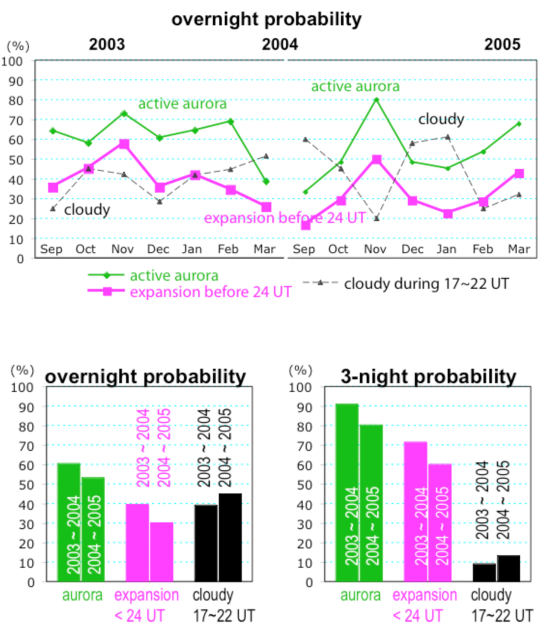
Observation rate was | ||||||
| month | auroral arc | active aurora | expansion < 24 UT | cloudy 17~22 UT | ||
| 2003.9 | 71% (20/28) | 64% (18/28) | 36% (10/28) | 28% ( 8/29) | ||
| 2003.10 | 61% (19/31) | 58% (18/31) | 45% (14/31) | 45% (14/31) | ||
| 2003.11 | 73% (19/26) | 73% (19/26) | 58% (15/26) | 42% (11/26) | ||
| 2003.12 | 67% (19/28) | 61% (17/28) | 36% (10/28) | 29% ( 8/28) | ||
| 2004.1 | 65% (20/31) | 64% (20/31) | 42% (13+1/31) | 42% (13/31) | ||
| 2004.2 | 72% (21/29) | 69% (20/29) | 34% (10/29) | 45% (13/29) | ||
| 2004.3 | 48% (15/31) | 39% (12/31) | 26% ( 8/31) | 52% (16/31) | ||
| 2004.4 | 64% ( 7/11) | 55% ( 6/11) | 45% ( 5/11) | 18% ( 2/11) | ||
| 2004.9 | 33% (10/30) | 33% (10/30) | 17% (5/30) | 60% (18/30) | ||
| 2004.10 | 52% (16/31) | 43% (15/31) | 29% (9/31) | 45% (14,13/31) | ||
| 2004.11 | 80% (24/30) | 80% (24/30) | 50% (15/30) | 20% ( 6/30) | ||
| 2004.12 | 58% (18/31) | 48% (15/31) | 29% ( 9/31) | 58% (18/31) | ||
| 2005.1 | 45% (14/31) | 45% (14/31) | 23% ( 7/31) | 61% (19/31) | ||
| 2005.2 | 61% (17/28) | 53% (15/28) | 29% ( 8/28) | 25% ( 7/28) | ||
| 2005.3 | 71% (20/28) | 69% (19/28) | 43% (12/28) | 32% ( 9/28) | ||
| 2005.4 | 47% ( 7/15) | 47% ( 7/15) | 20% ( 3/15) | 67% (10/15) | ||
| 2003 fall | 68% (77/113) | 64% (72/113) | 43% (49/113) | 35% (41/114) | ||
| 2004 spring | 62% (63/102) | 58% (58/102) | 35% (36/102) | 43% (44/102) | ||
| 2004 fall | 57% (72/127) | 53% (67/127) | 31% (39/127) | 46% (58/127) | ||
| 2005 spring | 57% (58/102) | 54% (55/102) | 29% (30/102) | 44% (45/102) | ||
| Total | 61% (270/444) | 57% (252/444) | 35% (154/444) | 42% (188/445) | ||
If tourist stayed 3 consecutive nights, chance to see aurora was | ||||||
| month | auroral arc | active aurora | expansion < 24 UT | cloudy 17~22 UT | ||
| 2004.9 | 67% (30/30) | 63% (29/30) | 30% (19/30) | 50% ( 2/30) | ||
| 2004.10 | 68% (27/31) | 52% (26/31) | 42% (24/31) | 52% ( 5/31) | ||
| 2004.11 | 100% (27/29) | 93% (27/29) | 70% (24/29) | 20% (2/29) | ||
| 2004.12 | 81% (30/30) | 71% (27/30) | 42% (20/30) | 74% ( 0/30) | ||
| 2004.1 | 97% (30/31) | 97% (30/31) | 77% (24+1/31) | 10% ( 3/31) | ||
| 2004.2 | 100% (29/29) | 100% (29/29) | 76% (22/29) | 3% ( 1/29) | ||
| 2004.3 | 77% (24/31) | 74% (23/31) | 48% (15/31) | 23% ( 7/31) | ||
| 2004.4 | 100% (10/10) | 100% (10/10) | 100% (10/10) | 0% ( 0/10) | ||
| 2004.8 | 100% ( 5/ 5) | 100% ( 5/ 5) | 80% ( 4/ 5) | 0% ( 0/ 5) | ||
| 2004.9 | 57% (17/30) | 57% (17/30) | 30% ( 9/30) | 23% ( 7/30) | ||
| 2004.10 | 71% (22/31) | 68% (21/31) | 52% (16/31) | 23% ( 7/31) | ||
| 2004.11 | 97% (29/30) | 97% (29/30) | 80% (24/30) | 0% ( 0/30) | ||
| 2004.12 | 81% (25/31) | 77% (24/31) | 61% (19/31) | 16% ( 5/31) | ||
| 2005.1 | 81% (25/31) | 81% (25/31) | 52% (16/31) | 19% ( 6/31) | ||
| 2005.2 | 93% (26/28) | 86% (24/28) | 71% (20/28) | 7% ( 2/28) | ||
| 2005.3 | 97% (28/29) | 93% (27/29) | 76% (22/29) | 3% ( 1/29) | ||
| 2005.4 | 85% (11/13) | 85% (11/13) | 54% ( 7/13) | 15% ( 2/13) | ||
| 2003 fall | 95% (114/120) | 91% (109/120) | 73% (87/120) | 8% (9/120) | ||
| 2004 spring | 92% (93/101) | 91% (92/101) | 70% (71/101) | 11% (11/101) | ||
| 2004 fall | 77% (98/127) | 76% (96/127) | 57% (72/127) | 15% (19/127) | ||
| 2005 spring | 89% (90/101) | 86% (87/101) | 64% (65/101) | 11% (11/101) | ||
| Total | 88% (395/449) | 86% (384/449) | 66% (295/449) | 11% (50/449) | ||